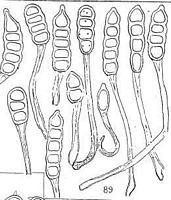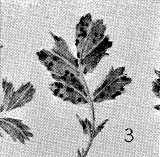|
 Phragmidium constrictosporum Phragmidium constrictosporum
SynonymsPhragmidium acuminatum
Phragmidium potentillae
Phragmidium constrictum
BiostatusPresent in region - Indigenous. Endemic
Images (click to enlarge)
Caption: FIG. 89. Phragmidium Potentillae P. Karst. Teleutospores from Acaena Sanguisorbae
Vahl. | 
Caption: FIG. 3. Phragmidium Potentillae P. Karst. Teleutosori on Acaena Sanguisorbae Vahl. |
Article: Dingley, J.M. (1969). Records of plant diseases in New Zealand. New Zealand Department of Scientific and Industrial Research, Bulletin 192: 298 p. Wellington:.
Notes: Cunningham (1924a) referred this species to Phragmidium potentilla Karst; in 1930 he
described it as an indigenous species occurring only on an indigenous host. It has been recorded
only from Otago and is of no economic importance. This species will have to be renamed as the
combination Phragoddhon acuminatum is already occupied.
Article: Cunningham, G.H. (1924). The Uredinales, or rust-fungi, of New Zealand: supplement to Part 1; and Part 2. Transactions and Proceedings of the New Zealand Institute 55: 1-58 Wellington:.
Description: 0. Spermogones amphigenous, in small scattered groups, pallid yellow.
I. Caeomata amphigenous, solitary or crowded, often confluent, elliptical, less commonly
orbicular, 0.5-1.5 mm. long, pulverulent, orange; encircled by a dense layer of cylindrical,
hyaline, incurved paraphyses. m Spores subglobose or elliptical, 20-26 X 15-22 mmm.;
epispore hyaline, finely and closely verrucose, 1-5-2 mmm. thick, cell-contents orange.
II. Uredosori hypophyllous, scattered, orbicular, 0.5-2 min. diam., pulverulent, orange,
encircled by a layer of cylindrical or clavate hyaline, incurved paraphyses. Spores subglobose
or obovate, 18-26 X 15-20 mmm.; epispore hyaline; finely and closely echinulate, 1-5 mmm.
thick, cell-contents orange; germ-pores scattered, numerous, obscure.
III. Teleutosori amphigenous, chiefly hypophyllous, scattered or confluent, orbicular, 0.25-3
mm. diam., pulvinate, compact, shining-black, naked, with numerous spores in each sorus.
Spores 1-5-celled, commonly 4, cylindrical, 55-95 X 18-25 mmm.; apex acuminate or
rounded, not thickened nor papillate, base rounded; constricted at the septa; wall golden -
brown, smooth, 2-4 mmm. thick; pedicel persistent, continuous with the spore, very long, up
to 200 mmm. by 4-7 mmm. thick, hyaline, hollow, not or slightly swollen at the base, lower
third closely"and finely verruculose; germ-pores 2-3 in each cell, conspicuous.
Distribution: Distribution: Europe; Asia Minor; Siberia; Japan; North America; Australia.
Notes: Two of the hosts are indigenous, A. novae-zelandiae var. pallida being endemic; A. ovina
has been introduced from Australia. (Cheeseman, 1906, p. 131, 1073.)
The New Zealand form does not agree in all particulars with the European, differing mainly
in the acuminate apex of the teleutospore. The cylindrical shape of the teleutospore, smooth,
light-coloured wall, constrictions at the septa, and very long slender pedicels, separate this
from other species found in New Zealand on Acaena. Specimens vary somewhat in the
degree of roundness or otherwise of the apex, as well as in the length of the pedicels, for in
certain sori the spores may all be rounded at the apex, and in others they all may be
acuminate; the pedicels may average 100 mmm. in length, or may be twice this length.
Generally, the larger the sorus the longer the pedicels.
Teleutospores are abundant in New Zealand, and in some collections literally cover the leaves
of the host. As they may frequently be found on the same plant with Phr. subsimile, and
occasionally even on the same leaf, the following method of separating the two on sorus
characters may prove useful :-
Teleutosori compact, shining-black, usually small .....Phr. Poteztillae.
Teleutosori pulverulent, greyish-black, usually large ........ Phr. subsimile.
It is difficult to separate caeomata from uredosori, as they generally closely resemble one
another; frequently sections are necessary to determine the difference. In this species,
however, the uredosori are generally surrounded by the ruptured epidermis, which persists for
a considerable time; this feature is generally absent from the caeomata, or, if not absent, is
invariably less noticeable.
|